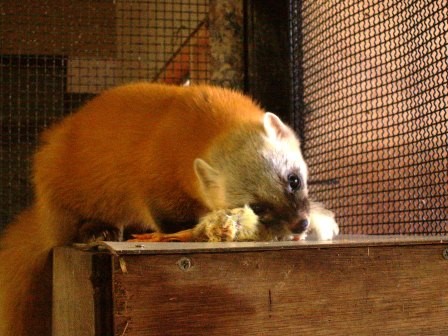



|
TOPICS BONOBO Chimpanzee "Ai" Crania photos Itani Jun'ichiro archives Open datasets for behavioral analysis Guidelines for Care and Use of Nonhuman Primates(pdf) Study material catalogue/database Guideline for field research of non-human primates 2019(pdf) Primate Genome DB 
Primate Research Institute, Kyoto University Copyright (c) |
Japanese Variation in the diets of Japanese martens Martes melampus
Yamato Tsuji, Takehiko Y Ito, and Yayoi Kaneko
Abstract
We reviewed dietary data in the literature for Japanese martens Martes melampus from 21 study sites covering the entire geographic range of the species, tested for differences in the diets of martens in evergreen and deciduous forests, and described variation in main diets and dietary diversity in relation to geographical and environmental variables. Fruits, mammals, and insects occurred at the highest frequencies in faeces throughout the speciesăŕ range. Mammal prey items and non-fruits were detected less frequently in scats collected in evergreen forests than in deciduous forests, while non-fruits were detected more frequently in evergreen forests. Three environmental variables (mean temperature, variation in the normalised difference vegetation index [NDVI], and snow depth) had significant effects on variation in dietary composition, but the relative contribution of each variable varied among food items. Geographical variables, on the other hand, had no significant effects on variation in dietary composition. Mean temperature explained the variation in insect feeding, which increased in forests with moderate temperature. Snow depth explained the variation in feeding on non-insects and other vertebrates; the former increased in forests with lower snow depth, while the latter increased in forests with higher snow depth. Variation in NDVI, on the other hand, had no effect on variation in feeding on a specific dietary category. The snow depth had a significant effect on the variation in dietary diversity, which became lower in forests with moderate snow depth. The high plasticity in the dietary composition and dietary diversity might represent a behavioural trait acquired by Japanese martens to allow them to expand their range into various forests with different food availabilities. When studying the variation in feeding behaviour of omnivorous carnivores, multiple environmental variables need to be considered equally.  Bibliographic information
Mammal Review https://doi.org/10.1111/mam.12147 https://onlinelibrary.wiley.com/doi/full/10.1111/mam.12147 2019/01/29 Primate Research Institute
|